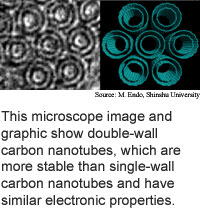
Method makes double nanotubes
Carbon nanotubes are a promising nanotechnology
building block. The tubes are made from rolled-up sheets of carbon atoms,
have useful optical, electrical and mechanical properties, and can be
smaller than 1 nanometer in diameter. A nanometer is one millionth of
a millimeter, or the span of 10 hydrogen atoms.
Carbon nanotubes can be grown as single tubes or multiwall tubes,
which are made up of successively smaller nested tubes.
Researchers from Shinshu University in Japan, the Institute for
Scientific and Technology Research at San Luis Potosi in Mexico, and the
Massachusetts Institute of Technology have found a way to fabricate pure
batches of double-walled carbon nanotubes.
Mixed batches of nanotubes are commonly available; pure batches
of double-walled carbon nanotubes have proved more difficult to produce.
The process makes it possible to better investigate the properties
of double-walled carbon nanotubes, according to the researchers. In theory,
double-walled nanotubes should be more thermally and chemically stable
than their single-walled cousins but with the better electrical and optical
properties of single-walled tubes. Double-walled carbon nanotubes could
eventually be used in gas sensors, electron emitters for displays and
scientific instruments, electronic devices like transistors and light-emitting
diodes, and composite materials.
The researchers' method purifies a mix of single and double-walled
nanotubes using hydrochloric acid, then oxidation at 500 degrees Celsius.
The process results in paper-like sheets of densely-packed bundles of
double-walled nanotubes.
Double walled carbon nanotubes will be ready to be used in simple
applications in two to five years, according to the researchers. The work
appeared in the February 3, 2005 issue of Nature.
Snapshots save digital evidence
Software organizes email by task
Wire guides terahertz waves
How it Works Files:
Pattern Recognition
Briefs:
Quantum crypto scheme goes one-way
Method makes double nanotubes
Material promises denser DVDs
Artificial cochlea tells tones apart
Nanotubes boost molecular devices
Avalanches up disk storage
Silicon chip laser goes continuous

Research Watch blog
View from the High Ground Q&A
How It Works
RSS Feeds:
News
Ad links:
Buy an ad link
Ad links: Clear History
Buy an ad link
|
TRN
Newswire and Headline Feeds for Web sites
|
© Copyright Technology Research News, LLC 2000-2010. All rights reserved.